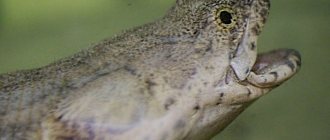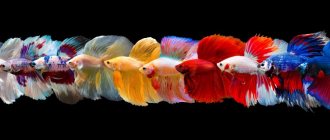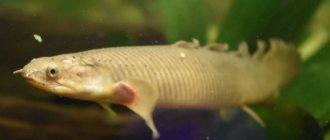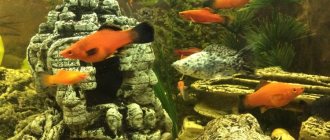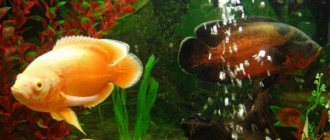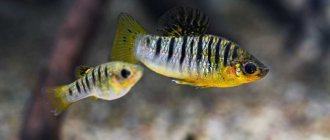Polypterus senegalus or Senegalese polypterus looks like it comes from the prehistoric period, and although it is often confused with eels, it is actually a completely different species of fish. Just by looking at Polypterus, it becomes clear that this is not a cute fish for a community aquarium. A divided and saw-like dorsal fin, well-defined teeth, elongated nostrils and large, cold eyes... you immediately understand why this fish is called the Senegalese dragon. Although it does somewhat resemble an eel, they are not related species.
General information
Polypterus senegalese Polypterus senegalese belongs to the predators of the polypterous family, a class of ray-paired fish.
At first glance, it resembles an eel or moray eel, but the multifeather has nothing in common with these representatives of the aquatic world. The first mention of fish dates back to 1829. At the time, due to its unique and distinctive appearance, scientists were unable to place this predator into any of the families. Then a new family in ichthyology was born - multi-finned fish.
The fact that these fish appeared many millions of years before our era is evidenced by the structure of their skeleton - it is cartilaginous. In addition, evidence of ancient origin is the ganoid scales, which contain a bone substance - ganoin, which gives it strength, like tooth enamel.
The Senegalese dragon is a lungfish. In addition to the gills, the respiratory organ is a modified swim bladder, resembling a lung. Thanks to this structure of the respiratory system, fish can live for some time without water. Therefore, the predator is able to crawl from a drying reservoir to a deeper one, and the fish survives the dry period with ease, burying itself in the silt.
Appearance
The Senegalese polypterus fish has an elongated, elongated body shape, which is covered with rough diamond-shaped scales. The color is gray-silver with an olive or bluish tint on the back and whitish on the belly. Young representatives have three dark stripes along the body, which disappear with age.
The Senegalese polypterus fish has an elongated shape and a dorsal fin of 8-12 spines
The shape of the fish's head is very similar to that of a snake, with small, semi-blind eyes, elongated long nostrils, which help to find prey. The mouth opening with a huge number of sharp teeth helps to quickly and deftly deal with even large fish.
The fins of the polyfin deserve special attention:
- The dorsal fin consists of 8-12 small spines, which is why this representative of the underwater world is called the dragon fish.
- The pectoral fins are large and fleshy. With their help, the predator moves on land.
- The pelvic fins are located closer to the tail and support the ganoid's body afloat.
The tail of the Polypterus fish is oval.
In its natural environment, the Senegalese polypterus fish reaches a length of 70 cm. The size of aquarium inhabitants depends on the size of the dwelling. In captivity, the dragon grows up to 40 cm.
Albino variety
In addition to the usual Senegalese polypterus, an albino variety is sometimes found. A characteristic feature is the white color of the body and fins. The pupils of an albino's eyes can be either standard red or black. In terms of content, albinos do not differ from ordinary polypteruses.
Albino Senegalese polypterus. Photo 1
Albino Senegalese polypterus. Photo 2
Habitat
Polypterus senegalese received its name due to its homeland - the African country of Senegal - and the river of the same name. Rbya is also found in other African rivers - the Congo, the Nile, as well as lakes Turkana and Chad.
Many-finned fish prefer shallow, swampy waters with abundant vegetation and slow currents. These fish love to hide among snags and in thickets of plants. The environment here is generally murky and opaque. For this reason, relics have practically no functioning organs of vision, but their sense of smell is very developed.
Fish like to hide in thickets of plants
During African droughts, most water bodies dry up. To survive the dry period, these fish burrow into wet mud or move to new “dwellings” with the help of massive fins. Local residents find polypterus in ditches and road holes formed after heavy tropical rains.
Polypterus delhezi
Perhaps the brightest of the polypteruses. The body is gray-olive with dark stripes and black dots. The sizes are not large. The body length will not exceed thirty-five centimeters. Suitable for keeping in a fairly modest sized aquarium. Active at night. Spends the whole day in hiding.
Water parameters: temperature – 24–28 °C, hardness – 5–8 °, pH – 6.0–8.0.
Kalamoicht calabarensis
Kalamoicht
It feeds on fry and small fish. Due to the structure of the body, it is able to penetrate into relatively small cracks and depressions. Read more about kalamoichta here .
Care and maintenance of Senegalese polypteruses (including albinos) - 7 rules
Keeping the Senegalese polypterus requires creating comfortable conditions for it. The albino fish variety does not require a special approach; keeping white fish is similar to the standard species. Next, we will consider the rules for keeping fish in an aquarium.
Rule 1. Spacious aquarium
In captivity, Senegalese polypterus grows up to 40 cm. This is a very large predatory fish, so an appropriate home is selected for it. The aquarium must have a volume of at least 200-250 liters. It is better if it is low, but with a large bottom area, because the relic prefers a benthic lifestyle. The aquarium must be covered with a heavy lid so that powerful fish cannot leave it.
The polyfin's home should be equipped with a good aeration system to ensure a regular flow of oxygen to maintain the aquarium's ecosystem, and filtration so that the ancient fish feels comfortable in the water.
For fish you need a spacious aquarium from 200-250 l (250 l in the photo)
Rule 2. Suitable water parameters
The optimal water temperature for polypterus will be 23-30 degrees, while its acidity in the aquarium should be at the level of 7 units. The Senegalese dragon has a neutral attitude towards hardness - it will be equally comfortable in both soft and hard water.
But it’s worth paying attention to the chemical composition of the hydraulic system in the aquarium. Increased concentrations of nitrogenous compounds and phosphates in the water, which are released by the aquarium inhabitants themselves, cause illness and death of fish. It is very important to periodically test for the presence of these chemical compounds and use drugs that neutralize excess hazardous substances in water.
Rule 3. Rounded soil
When selecting soil, you should take into account that Polypterus senegalese is a bottom-dwelling fish that feeds at the bottom of the aquarium. Select a fraction of the substrate that can be easily cleaned of food residues. For example, small rounded pebbles are perfect.
For Senegalese fish, choose a soil fraction that can be easily cleaned of food residues
Rule 4. Plants are chosen by the owner, not the fish
Many-feathered fish are indifferent to plant food; they are a completely carnivorous animal, so any kind of vegetation is suitable for an aquarium. The aquarist should be guided by his own taste and preferred design. You can opt for anubias and aquarium fern.
Rule 5. Coverings (decor) are required.
Aquarium polypteruses are very fond of hiding in various shelters during the daytime, so it definitely wouldn’t hurt to equip the tank with them. Snags, grottoes, caves - all this will be a favorite place for the aquarium pet.
In an aquarium with polypterus, there must be shelters in which the fish likes to hide
Rule 6. Twilight as lighting
For lighting, aquarium dim lamps of the blue spectrum, imitating the light of the moon, are suitable. This will recreate the natural habitat of the animal, and the owner of the aquarium will be able to observe the active night life of the aquarium dragon in the twilight.
Polypterus congolese or ornatipinis ((Polypterus Ornatipinnis)
It also has the unofficial name “Marble Dragon”. Can reach a length of 40 centimeters. Very aggressive. It leads a hidden lifestyle, so you can only see it while eating.
The color is gray-brown with a mottled white pattern, the belly of the fish is lighter yellowish, the head is covered with a mesh pattern.
The minimum volume of the aquarium is 400 liters. Water parameters: temperature 24-27 ºC, pH 6.0-8.0, dGH 5-25°.
Compatibility
Due to the fact that Polypterus is a rather large fish, it will not be able to coexist friendly with all representatives of the aquarium fauna. The main condition for getting along is the impressive size of the neighbors. The mate must not be smaller than half the size of the polyfeather, otherwise it risks becoming its food.
Young predators get along well with each other in an aquarium, but with age, polypterus become possessive and try to eliminate “relatives” as competitors.
It is best to add nimble and large neighbors to multi-feathers, such as:
- acara;
- astronotuses;
- Indian knives;
- shark ball;
- cichlids;
- knife fish;
- giant gourami;
- macropods;
- synodontis;
- apteronothus and others.
In addition to the fact that the aquarium dragon is a hunter, it itself can become a victim of other, more formidable predators. The most dangerous for him are large piranhas. Despite the fact that the ganoid's strong "armoured" scales serve as the ganoid's natural "armor", its unprotected abdomen is vulnerable to the piranha's many sharp teeth. In addition to the abdominal part, they gnaw off the fins and tail of relics, which also leads to their death.
In addition to piranhas, you cannot combine multifins with armored pike, sucking catfish and small fish. The latter run the risk of being eaten by polypterus.
Young polypterus get along well with each other
Compatibility with other fish
In terms of compatibility, the most important parameter is the size of neighboring individuals. The fish should be the same size. The following species will be good friends for polypterius:
- apteronothus;
- shark barbs;
- butterfly fish;
- giant gourami;
- astronotuses;
- cyclides are large;
- Indian knives;
- African cancers.
Young polyfins can be kept in a small school, but for adult fish such keeping is unacceptable. Sometimes adults can attack waterfowl that are larger than them, but such situations do not happen out of malice, but due to poor eyesight.
In terms of compatibility, the most important parameter is the size of neighboring individuals.
Reproduction and breeding
To breed polypterus, you will need to create special conditions, which we will discuss later.
Sex differences
Breeding Senegalese polypterus at home is a labor-intensive process, although quite possible. The first difficulty lies in correctly determining the sex of individuals. Signs of gender are very weakly expressed. Young representatives are completely impossible to distinguish.
Adult females have a flattened head, making it appear wider. Mature females are larger than males and have a noticeable abdomen. In males, the main difference is the anal and dorsal fin. They are thick, wide, spade-shaped.
Male
Female
Getting offspring
Sexual maturity in the Senegalese dragon occurs at 10-12 months. At this time, primary sexual characteristics are noticeable and one can be sure that females and males are present for mating.
In nature, the mating season of polypterus occurs from May to October during the rainy season. Therefore, in order to stimulate spawning in an aquarium, you need to create suitable conditions, namely lower the water temperature by 3-5 degrees.
The fish body will independently begin preparing for the appearance of future offspring - in females, at this time, the abdomen swells from the volume of eggs in it, and in males, the anal fin swells. The couple spends a lot of time together, the animals rub against each other, the male bites the fins of his partner. This game can last for several days. When both are ready to spawn, the male clasps the anal and caudal fins of his partner, receiving eggs from her and fertilizing them. During one spawning, the female lays up to 4000 eggs.
Germ
Larva
Senegalese polypterus fry
The pea-sized fertilized eggs attach to the aquarium flora or fall to the bottom. To protect future offspring, it is better to cover the bottom of the spawning area with moss. Along with Javanese, Christmas tree moss is used. It will help the eggs attach firmly and protect them from death.
After the eggs are swept, they are stored together with the moss in a separate container with a powerful filtration and aeration system. Since Senegalese dragons do not have the instinct to care for offspring, the eggs can simply be eaten by the “parents”. The incubation period lasts four days, after which the first larvae of new dragonets hatch from the eggs.
When they are born, relict fry have gills, which degenerate after a month, and the young individuals become able to swallow air at the surface of the aquarium.
First, the young animals are fed with ciliates or Artemia nauplii. After feeding, any remaining food is immediately removed, and water is changed frequently (at least 20%).
The fry are sorted daily and the larger ones are separated. The predator instinct of these fish manifests itself very early, and they can attack their weak brothers, bite their gills, destroying a huge number of relatives.
When the young fish reach 5 cm, the fish are already able to safely coexist together in schools, the feeding regime becomes simpler, and the fry do not require special food.
The fry are sorted daily and the larger ones are separated.
Diseases and prevention
Multi-feathers do not have any specific diseases. All animal health problems are associated only with improper care, namely feeding regimen and living conditions.
The most common disease is obesity. This is caused by an incorrectly formulated diet, too frequent feeding, or excess freeze-dried food. To treat predators, you should put them on a diet: choose the optimal diet of bloodworms and low-fat food and give food no more than once every three days.
Due to contaminated water and poor filtration, ammonia poisoning occurs in polyfins, intoxication begins, and the gills become purple. The pet loses its appetite and often rises to the surface to swallow a fresh portion of air. If such symptoms occur, it is necessary to carry out a general cleaning in the multi-feather’s home - completely change and disinfect the water, thoroughly clean the soil and all interior items.
Individual with signs of overeating
Upon careful examination, you can notice small parasitic white worms with a black pattern on your pet’s head – monogenea. Their activity negatively affects the health of predators; the latter become lethargic, inactive, do not accept food well and often swallow air. Immediate treatment is carried out with azipyrine.
Also, animals caught in the wild can be carriers of leeches, so before moving into the aquarium community they are kept in quarantine for some time.
To prevent diseases, you should follow simple rules for keeping aquarium inhabitants:
- carry out filtration, aeration and water replacement;
- remove leftover food in a timely manner and do not overfeed your pets;
- Place only purchased treated soil on the bottom, and not self-collected soil.
When the first signs of illness appear, it is important to isolate the sick animal.
To prevent disease, it is necessary to regularly aerate the aquarium.
Feeding
The multi-feathered Senegalese is unpretentious in feeding and will eat almost anything as long as it is alive. If the fish is too big to swallow, he will try anyway.
That is why the neighbors in the aquarium should be at least half the length of the polypterus. Adults can be fed once or twice a week.
Fortunately, you can feed him other foods as well. Granules or tablets that fall to the bottom, live, frozen, sometimes even flakes, he is not capricious.
If you feed it with artificial food, the predatory instinct is reduced, allowing you to keep it with smaller fish.
Interesting Facts
- The appearance of the relict polyfeather is very attractive, which is why it is often shown in aquariums and aquarium halls.
- Polypterus become attached to their breadwinner and, when he appears, they come out of hiding. Animals love to eat food directly from their owner's hands.
- A fish can live without water for a long time, provided that the surface of its body is constantly moistened.
- Underwater scientific videos are often filmed in the habitats of the aquarium dragon; its behavior in nature is very interesting to observe.
- In the last century, photographs of dragon fish were worth a lot of money.
Polypterus become attached to their provider
Reviews
Senegalese polypterus is a unique aquarium animal, more suitable for experienced aquarists or scientific observations. For beginners, keeping such a pet will be a troublesome task: caring for a large aquarium is labor-intensive, the choice of neighbors in the aquarium community is limited, the predator hides in shelters almost all the time and it is not interesting to observe it at home. But if this animal does settle in the aquarium, its owner can be considered the happy owner of a real relic value.
Would you like to have a polypterus? Or maybe among our readers there are happy owners of such a fish? Share your experiences and thoughts in the comments.
Endlicher's Polypterus or Tiger (Polypterus Endlicheri Bichir)
Polypterus Endlichera
Polypterus Endlichera
Quite a large representative of the species. Distributed from tropical zones of Africa to the Red Sea. It can reach seventy-five centimeters in length. Discreetly painted. Gray-blue body with pronounced stripes. Very strong, but slow. In nature it is most active at night, but in a home aquarium it will always be active. It is possible to keep it in a home aquarium, but only separately in a volume of at least a thousand liters. Feeding is possible only with live food.
The most comfortable water parameters for keeping: temperature 22-27°C, pH: 6.0-8.0, 5-25°H.
